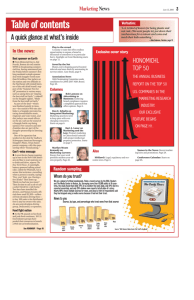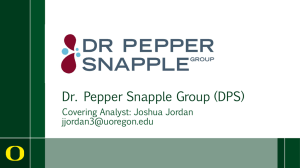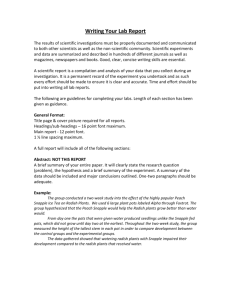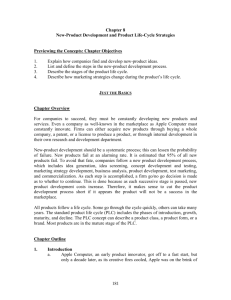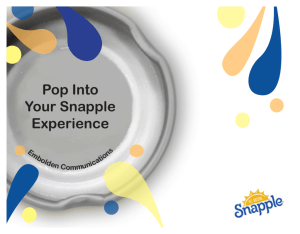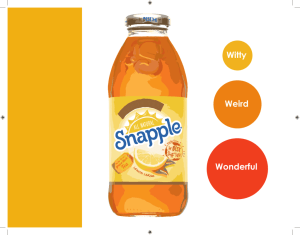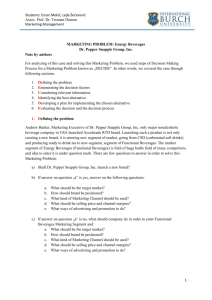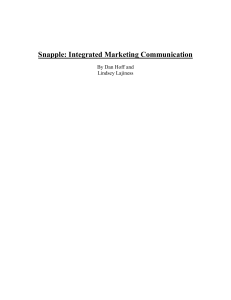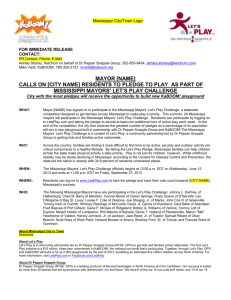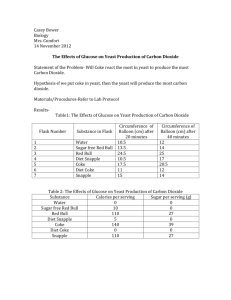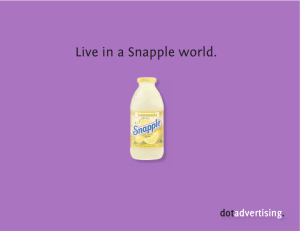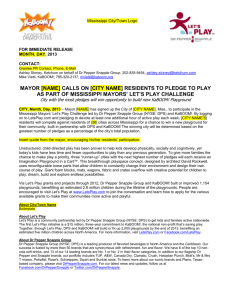Mallory Kaplan, Cristina Mungilla, Hillary Shepheard, Camila
advertisement
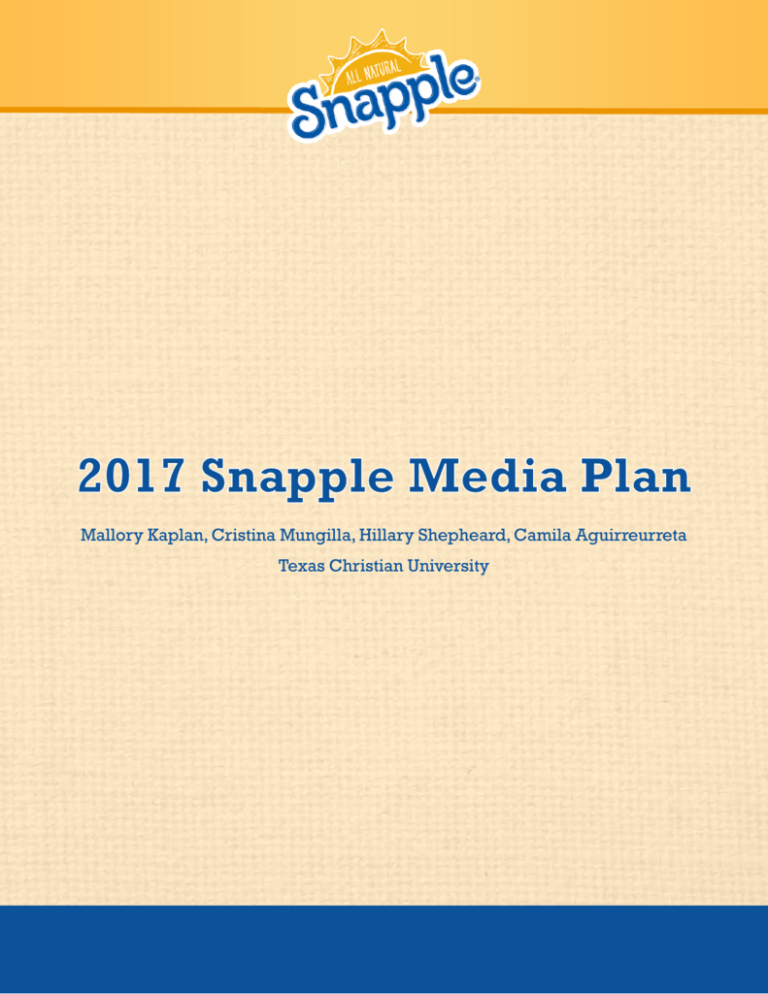
Mallory Kaplan, Cristina Mungilla, Hillary Shepheard, Camila Aguirreurreta Texas Christian University TABLE OF CONTENTS Executive Summary Page 3 Situation Analysis Page 10 Objectives Page 10 Strategy Page 13 Media Mix Page 15 Budget and calendar Page 17 Conclusions Page 19 References / Appendices Page 21 2 Executive Summary The following report was conducted in order to gain valuable insight on key characteristics of Snapple as a brand. The information offers a closer look at the strengths, weaknesses, opportunities and threats of Snapple, as well as analyzing its main consumers. Research was conducted to analyze geography, timing, purchase cycle and media analysis. This report will aid Snapple in increasing brand awareness and brand relevance while increasing purchase frequency amongst all consumers. For this report Social Enginuity utilized Mintel, MRI+, Ad$pender, SimplyMap and other databases to gain more insight on the brand and its market. Snapple’s main competitors are AriZona, Lipton Pure Leaf, Gold Peak Tea and Sweet Leaf. Snapple Tea is most heavily consumed in what it considers the “Heartland” area of the Northeast making this a key market to target while targeting the rest of the United States to increase brand awareness as well. The primary target audience is working men and women from 18 to 45 and the secondary target audience is working men from the ages 22 to 49. Based on the data, there are a number of options that may help Snapple reach its objectives. Social Enginuity plans to advertise using TV, magazines, radio, digital marketing and guerilla marketing. We plan to increase reach and frequency during the months before and during what is considered the summer season. With this we intend to reach the target audience during peak months for tea consumption. The majority of the budget will go to non-traditional media while the rest of the budget will 3 go to traditional media to reach a large part of the target audience at key times. This will increase overall brand awareness. Situation Analysis Brief history of Snapple Snapple is currently owned by Dr. Pepper Snapple Group based in Plano, Texas. Snapple was founded in 1972 by Leonard Marsh, Hyman Golden and Arnold Greenburg and started as a grassroots company from Greenwich Village, New York. The company started as the Unadulterated Food Corp. and changed to Snapple Beverage Corp. in 1993. Snapple’s products include tea (regular and diet), juice drinks, lemonade, additional flavors and bottled water. Most Snapple drinks have Kosher certifications from the OK Kosher Agency, with the exception of fruit punch and grape. In August 1992, the company signed new contracts with beverage distributors and managed to expand its distribution to every major city in the U.S. The company also managed to keep its overhead costs low and payroll short by not having any manufacturing facilities, but by having agreements with more than 30 bottlers across the country. The Quaker Oats Company bought Snapple in 1994 for $1.7 billion. The company was later sold in 1997 to Triarc for $300 million. Triac then sold Snapple to Cadbury Schweppes for $1.45 billion in September 2000. In May 2008 it was sold to its current owners. Descriptions of product and current competition Snapple currently possesses five product categories. These include eight tea and juice diet drinks, 4 24 regular drinks including Snapple spring water, juice drinks and teas, 14 tea drinks, 19 juice drinks and seven additional flavors in aluminum cans. Snapple has been also looking to pursue new product categories by creating contracts with other brands that would benefit from its manufacturing and distribution capabilities. An example of this, was in 2012 when Snapple launched its Lightly Sweetened Teas. They were all natural white teas with less sugar than the rest of the company’s products. To increase its product variety, Snapple has also been investing on more package sizes, such as SnapTea gallons under the company’s brand. AriZona is the brand with the highest sales volume, with about $122,321,680 in sales over the last 52 weeks, followed by Lipton AOX with $59,967,092 and Brisk with $50,538,682. Snapple is fourth in the category, but it has been growing over the past year with a 7.8% increase, whereas AriZona and Brisk have been declining (NSAC, 2015). Timing Considerations Snapple will run a national campaign in 2017 for the duration of 12 months. The campaign will begin January 1, 2017 and end on December 31, 2017. Tea is a regularly consumed product in the United States with a heavier demand during warmer weather or summer months such as May through August, therefore heavier advertising will take place during the months of May, June, July, and August. In addition to heavier advertising, a sweepstakes competition will run from June 1st through September 1st to help increase top of mind awareness and help drive trial. 5 Target Audience - General Profile The members of Snapple’s general target audience are Caucasian male and females between the age range of 18-45 with an income of $50,000 plus and a busy lifestyle. This group is further divided into younger millennials and older millennials with the age groups being 18-29 and 3045. The younger age group is more tech savvy and has interests that focus more on popular culture and entertainment. The older age group focuses on people who are married with children, have high paying salaries to enjoy themselves and a desire to live a healthy lifestyle. Target audience - specific media usage profile Potential Persona 1 Meet Chloe! Chloe is 25 years old, career oriented and loves her job as an account executive for an ad agency, but she loves her social life as well. Her salary averages at $50,000 or more per year. She enjoys brunch with friends on Sundays and nights out on the town every Saturday. Chloe watches shows like The Bachelor while also watching Good Morning America every morning while getting ready for work. She takes yoga classes with her friends and may occasionally work out by herself but isn’t a freak about being in shape. Chloe loves fashion and goes shopping with her friends frequently while reading magazines and blogs to keep up with the latest trends. 6 Potential Persona 2 Meet Chris! Chris works hard at his job as an accountant but also plays hard on the weekends. This 27 year old loves sports and upholds his weekly happy hour tradition at the local sports bar with his friends. Currently, Chris earns about $50,000 per year in his accountant position, but he wishes to earn more as his career develops. Chris tries to stay in shape but doesn’t have too much time to focus on his fitness so he makes healthier choices in his diet instead. He goes out on the weekends with his friends to the bars and clubs and is currently dating but is not yet in a serious relationship. Chris is constantly on the go and lives a very upbeat lifestyle. He enjoys popular music, especially while at work, and watches shows like Jimmy Fallon at night because not only is it entertaining but it keeps him up to date with what’s going on in the world. Potential Persona 3 Meet Rachel! Rachel is a working mother of two and is 36 years old. Her husband works fulltime as a lawyer, and she works part-time as a real-estate agent. Their combined household 7 salaries average around $75,000 per year. Her children are 5 and 7 years old, so her part-time job allows her to take care of her kids and her home. Rachel doesn’t have much time to spare between home and work but when she does, her hobbies include cooking and date nights with her husband and their friends. Her favorite channel is the Food Network and she loves reading magazines such as Better Homes & Gardens, which help her not only decorate her own house but the houses she sells. Competitive Analysis Snapple’s spending on media. From the current year to date, Snapple’s total media budget has been $24,185,900 million. They have this budget amongst four main media: outdoor, network, cable and spot TV. The majority of the budget has been allocated to both cable and network TV, partly because of the higher prices of that medium (Ad$pender, 2015). Snapple has also seen success from shifting its traditional media dollars to include digital and online content. By doing this, Snapple is able to reach its target market comprised of 18 to 49 year olds. Snapple has also partnered with the branded entertainment space to increase their campaign’s relevance and awareness. Past branded entertainment partnerships have included: The Amazing Race, The Apprentice, 30 Rock, and America’s Got Talent (NSAC, 2015). Competitors’ spending on media. The Ready-To-Drink category has been very competitive for the past years, which has made the amount of media dollars spent by this category very high. Snapple’s biggest competitors include: Lipton, Pure Leaf, Gold Peak, Sweet Leaf and AriZona. These were also some of the largest spenders in media in 2014 for the RTD tea category. For big 8 spenders such as Lipton, Snapple and Gold Peak, TV has received the most amount of media budget. From the current year to date Lipton has spent $1,108,800 million in a combination of network and spot TV and Gold Peak has spent a total of $16,159,200 million in network, cable and spot TV. Snapple has also allocated a significant portion of its spending budget on TV with a total of $13,810,500 million on network, cable and spot TV (Ad$pender, 2015). Competitors with smaller budgets, such as Nestea have focused their media budget on print and local outdoor support (NSAC, 2015). Most competitors in the category have prioritized traditional media over digital, but the largest competitors within the digital space are Fuze, Snapple, Lipton and Gold Peak (NSAC, 2015). Digital reporting is harder to obtain, since industry measurements and standards are still being established. Nonetheless, Snapple has seen success of shifting toward digital media to reach its younger audiences. All of the competitors within the category, with the exception of Lipton, focus all of their spending dollars on their base products. Lipton has to divide its support amongst its Base, PureLeaf, Natural and Brisk sub-brands (NSAC, 2015). Ad$pender Media Report current year to date 1/1/2015 – 9/30/2015 9 SWOT Objectives The campaign’s main objective is to create an integrated 2017 holistic marketing campaign that grows Snapple Trademark volume in the United States (NSAC, 2015). The predominate targeted audience is Caucasian men and women from the ages 18-45 across the U.S. The household income for this target audience ranges from $50,000 to $75,000 and higher. Snapple has divided its marketing efforts into two main geographic areas: Heartland and Non-Heartland. Heartland, is the Northeast area of the U.S., it comprises nearly half of Snapple TM annual volume and is home to Snapple’s heavy user consumers. The Non-Heartland is the rest of the country that accounts for 50% of Snapple volume and is where the majority of light users reside (NSAC, 2015). To effectively reach Snapple’s targeted consumer and drive the desired volume sales, Social Enginuity established a main objective for the Heartland and Non-Heartland target areas. The Heartland objective is to increase the purchase frequency of the Heavy User Buying Rate from 10 buying Snapple product from nine times per year to ten. The objectives for the Non-Heartland targeted area are to convert high awareness light users to top of mind brand awareness through trial and to increase the purchase frequency of these light users from buying Snapple product one time per year to at least three times per year (NSAC, 2015). Reach and frequency objective levels will be established throughout the course of the campaign to measure its effectiveness. The traditional media reach and frequency levels will focus on four months: March, April, May and June. During the course of these months, it is expected to obtain 80 percent of the targeted audience with a frequency of four times per month. Traditional media will only be allocated to these months to help raise awareness for the Snapple Summer Sweepstakes. Nontraditional media is set to run throughout the entire course of 2017. Therefore, three reach and frequency levels have been determined. High level months will expect to obtain 80 percent of the targeted audience with a frequency of four times per month. These months will include May, June, July and August. Medium level months will be expected to obtain 65 percent of the targeted audience with a frequency of three times per month. These months will include March, April, September and October. Low level months will be expected to obtain 50 percent of the targeted audience with a frequency of two times per month. These months will include January, February, November and December. Nontraditional media has been distributed in this manner so that it it supports traditional media’s off-seasons, and increases awareness for the Summer Snapple Sweepstakes. There is such a discrepancy between traditional and nontraditional media reach and frequency levels, because the targeted 11 consumer has shown to respond more to digital rather than traditional advertising campaigns (Mintel, 2015). Traditional Objectives Chart 2017 National Plan Goals National Reac %Sha Est Freq GRPs Plan h re $(000) January 0 0 0 0 0 February 0 0 0 0 0 March 80 4 320 11.8 5 April 80 4 320 11.8 0 May 80 4 320 11.8 0 June 80 4 320 11.8 0 July 0 0 0 0 0 August 0 0 0 0 0 September 0 0 0 0 0 October 0 0 0 0 0 November 0 0 0 0 0 December 0 0 0 0 0 ------- -------------National 1280 47.2 15000 Media Nontraditional Objectives Chart 2017 National Plan Goals National Reach Freq Plan GRPs %Shar e Est $(000) January 50 2 100 4.1 $ 615,000 February 50 2 100 4.1 $ 615,000 March 65 3 195 7.9 $ 1,185,000 April 65 3 195 7.9 $ 1,185,000 May 80 4 320 13 $ 1,950,000 June 80 4 320 13 $ 1,950,000 July 80 4 320 13 $ 1,950,000 August 80 4 320 13 $ 1,950,000 Septembe r 65 3 195 7.9 $ 1,185,000 October 65 3 195 7.9 $ 1,185,000 Novembe r 50 2 100 4.1 $ 615,000 Decembe r 50 2 100 4.1 $ 615,000 -------- -------National Media 2460 12 100 -------$ 15,000,000 Strategy In order to increase Snapple Trademark volume among Heartland and Non-Heartland men and women ages 18-45, a combination of traditional and nontraditional media will be used. Magazines, radio and cable TV will be used as the campaign’s forms of traditional media. These traditional media choices were made based on the target audience’s high consumption rate and their wide capacity of reaching the targeted audience at a national level (Mintel, 2015). Nontraditional media that will be used includes: paid search advertising, display advertising, blog advertising, outdoor advertising and social media. Traditional media that now has a digital component such as online radio and TV have also been included as part of the nontraditional media to be used. Since Snapple’s marketing objective was to increase Snapple Trademark volume in the U.S., Social Engenuity decided that a sweepstakes contest strategy would help drive sales among the target audience. The sweepstakes contest is meant to drive sales and help raise awareness of Snapple mainly in the Non-Heartland area. Since Heartland Snapple consumers already have a brand relevance of 50%, the sweepstakes contest will help Non-Heartland consumers convert from a high awareness percentage (currently 90%) to top of mind brand awareness percentage (currently 15%) (NSAC, 2015). Consumers can participate by buying any of Snapple’s glass container products and looking to see if they have purchased the winning bottle cap. The contest winner will win an all-inclusive trip for five to New York City, Snapple’s birthplace. The four-day trip will include a shopping spree sponsored by Snapple, sightseeing, and a celebrity meet and greet with Jimmy Fallon. This will continue to motivate Heartland consumers to purchase their 13 favorite Snapple products, and drive Non-Heartland target consumers to try Snapple. This strategy is estimated to increase the Heavy User Buying Rate from buying nine times a year to ten, and increase the Light User Buying Rate from one time a year to three (NSAC, 2015). The media plan will begin January 1st, 2017 and will continue until December 31st, 2017. The nontraditional media will run throughout the entire course of the year. Its media schedule is divided into three levels of frequency: low, medium and high. The first two and last months of the year will be low frequency levels, since medium and high frequency level months require more budget allocation to build awareness for the sweepstakes contest and continue to drive sales. March, April, September and October will be medium frequency levels. Traditional media, such as cable TV, magazines and radio, will be used in combination with nontraditional media during medium frequency level months, to help raise Snapple brand awareness on a national level. The sweepstakes contest will run May through August, and these will be the high frequency level months. During the course of these four months, traditional and nontraditional media will culminate to raise national awareness about the sweepstakes contest and will promote an overall volume increase in sales. The contest winner will be announced September 1st, so that targeted audiences have the opportunity to participate in the contest over the course of four months. 14 Media Mix Television: Cable TV, Network TV, & Online Streaming The dayparts chosen for traditional include network TV daytime, network TV early news, network TV prime, cable daytime, cable prime, and cable late fringe. The early news targets working adults who watch the news either while getting ready for work or getting their family ready for the day. The daytime selections target stay-at-home mothers or women that work flexible part-time jobs in order to take care of their family as well. The prime times and late fringe cover a large demographic, however the late fringe is geared more towards the 18-29 age group that watches shows such as Jimmy Fallon. As for the online streaming of Netflix and Hulu, the demographic is the age group 18-29 and certain shows that resonate with Snapple’s target audience will be targeted such as How I Met Your Mother. Radio: Network & Digital Audio The dayparts chosen for network radio include daytime and evening. The daytime radio will target the working demographic that drives to lunch everyday and will additionally target the 15 stay-at-home mothers during the months leading up to the Snapple Summer Sweepstakes. The digital radio will include iHeartRadio, Spotify, and Pandora. Spotify will specifically target the younger age group from 18-29 while iHeartRadio will target this audience in addition to the older age group from 30-45. Pandora will be used to target the older women. Magazines The magazines chosen for this campaign include Better Homes and Garden, Cosmopolitan, and Entertainment Weekly. Because women readership is so high in the category of magazines, this media will focus on reaching women from the ages of 18-45 with Better Home and Gardens more focused on the older women and Cosmopolitan and Entertainment Weekly focused on the younger 18-29 age group. The MRI+ data of adults who drank Snapple in the last six months showed a significantly high readership among these three magazines as well as a high propensity to drink RTD tea for each one. Outdoor For the outdoor advertising, a total of $7.5 million was allocated. This widespread medium will be used to raise awareness and it is expected to target both men and women of the targeted audience. A mix of static and digital billboards, transit and dynamic displays will be used in key high-traffic areas in both Heartland and Non Heartland geographical locations. A dynamic display placed outside stadiums and sports arenas will run all year to reach and impact the male demographic. Transit and billboards advertisements will only run from March to October, to complement the rest of non traditional media. 16 Social Media For this campaign, all social media platforms currently in use by Snapple will be utilized with an addition of Pinterest due to its significantly large women follower base. Social media will account for the engagement aspect of this campaign. For blog advertising, paid placement will be used to target health related blogs featuring up and coming food and beverages. Paid Search and Display Ads Due to this campaign centering solely around a sweepstakes competition, it is essential to allocate a significant part of the budget to paid search because consumers will immediately seek out information in this form. Being the first result and providing quality information allows the consumer to trust in the brand and develop a favorable attitude towards not only the sweepstakes, but the Snapple brand as well. Budget and calendar Traditional Media Budget 17 Traditional Media Calendar Nontraditional Media Budget 18 Nontraditional Media Calendar Conclusions More budget was allocated toward reaching women than men within the targeted audience, because women tend to make the purchasing decisions for their entire households (Mintel, 2015). If more budget was allowed, Social Enginuity would use these available funds to target men ages 18-49 during sport-related events. Since these events, such as the Super Bowl, March Madness and fall football season, occur during the fall and spring months, these advertisements would keep Snapple on top of mind brand awareness during the campaign’s off-season months. Social Enginuity is confident that the established objectives will be met, and Snapple will increase its volume in sales and overall brand awareness. If Snapple considers Social Enginuity’s 2017 campaign as successful, further plans may be made in the future to provide a wider budget freedom to continue to develop result-driven campaigns. 19 This media plan will successfully use the budget available to reach the target audience in the most cost-effective and creative way. The majority of volume increase in sales will be expected to come from the high consumption level months, to take advantage of the seasonality of the Snapple product. Although this plan relies more on non-traditional media, Social Enginuity is confident that the appropriate target audience will comply with recently developed forms of non-traditional media. Since Snapple behavior is inventive and “delightfully creative”, Social Enginuity approached this media plan with the same attitude. 20 References 2015 – 2016 Snapple Case Study. (2015). Ad$pender. (2015). Snapple Competitive Media Report. Hoover’s. (n.d.). Snapple Beverage Corp. Competitive Landscape. Retrieved December 9, 2015 from: http://subscriber.hoovers.com/H/company360/competitiveLandscape.html?companyId=1012 14000000000&competitorId=42106000000000&competitorId=41815000000000&competitor Id=46046000000000 Hoover’s. (n.d.). Snapple Beverage Corp. Retrieved December 9, 2015 from: http://subscriber.hoovers.com/H/company360/fulldescription.html?companyId=10121400000 0000 Phillips, Jocelyn. (2014). RTD Tea Production in the US. Retrieved December 9, 2015 from: http://clients1.ibisworld.com/reports/us/industry/default.aspx?entid=4297 O’Donnell, Fiona. (2014). Marketing to Men. Retrieved December 9, 2015 from: http://academic.mintel.com/display/680547/ Mintel. (2014). Non-Alcoholic Beverages Occasions – US. Retrieved December 9, 2015 from: http://academic.mintel.com/display/692543/?highlight#hit1 Sisel, Elizabeth. (2015). Tea & RTD Tea – US. Retrieved December 9, 2015 from: http://academic.mintel.com/display/716569/ 21 Snapple History. (n.d.). Retrieved December 9, 2015 from: http://www.snapple.com/history Snapple Products. (n.d.). Retrieved December 9, 2015 from: http://www.snapple.com/products Snapple. (n.d.). Retrieved December 9, 2015 from Wiki: https://en.wikipedia.org/wiki/Snapple 22
